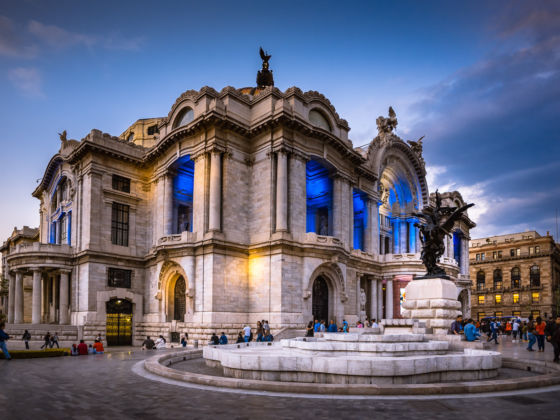

Most people have an opinion about Mexico City, often abbreviated CDMX (for Ciudad Mexico) or DF (for "Distrito Federal"), typically involving one or more of the following adjectives: polluted, poor, dangerous, chaotic (ok, so the last one's true), though they've never been there. For people who have been there — or better, have lived there — there's a centrifugal force we can't quite explain that pulls us back again and again. In all the chaos, there's remarkable order. Alongside soaring skyscrapers, there are centuries old temples. You can buy a street stall or market taco for 5 pesos at lunch, then sit down for a six-course "new" Mexican dinner for 500 pesos. You can wander through Frida Kahlo's Casa Azul and relive the high period of 20th-century Mexican painting, then stumble upon a pop-up street gallery exhibiting punk art. You can dive headlong into the city's intensity or escape into mountains in 30 minutes. In short, though plenty of places market themselves as having "something for everyone," Mexico City really does.
Any time of the year is good to visit Mexico City. Its temperate climate is almost perfect year round, but you should take into account some considerations. Rains peak between June and September, and even though tropical storms don’t affect the city significantly, there can be heavy pours every single afternoon for weeks, especially in July. The temperature rarely goes below 50 degrees Fahrenheit, but from December to February is when it definitely hits the coldest temps around here. May is usually the hottest month with temperatures reaching up to 86 degrees Fahrenheit. If you’re looking to escape crowds, consider visiting Mexico City during Easter when most locals usually take a break from the city.
Mexico has its own currency, the peso. The conversion is about $18.01 per 1 USD. Tipping is expected in most places where a service is provided, including restaurants and bars where you should expect to tip between 10 and 20 percent of the total bill. Alternatively, you could tip a bartender 10 pesos per drink. In hotels, you should tip bellhops between 20 and 50 pesos, and housekeeping 25 to 50 pesos per day. If you’re taking a tour, depending on the length of the tour, tip your tour guide between 100 and 300 pesos. Don’t worry about tipping in cabs, as locals never do, but 10 pesos would be appreciated if your driver helped you out with your luggage. If you’re driving your own car, gas station attendants expect 10 pesos for filling up the car; you’re not allowed to pump your own gas.
Spanish is the primary language in Mexico, but you won’t have a problem finding English speakers in tourist areas. A little bit of Spanish will open a lot of doors here, so it’s better to come prepared with a dictionary or a translation app. Here are a few important phrases (and some local slang) to get you started:
Mexico City can be quite chaotic in terms of transport, but the Metro will get you anywhere pretty efficiently. You can buy single tickets (5 pesos) in any train station, or a rechargeable card for 10 pesos extra (this card can also be used on the Metrobús). Try to avoid it during peak hours (from 6:00 AM to 9:00 AM and from 6:00 PM to 8:00 PM), though, and always keep an eye on your belongings. The Metrobús has its own dedicated lane and can get you around the main attractions quite quickly if being underground isn’t for you. Avoid the old busses, also known as peceros, at all costs. They’re unreliable, difficult to navigate, and not the safest form of transportation in CDMX. If taxis are more your thing, favor Uber and the taxis recommended by your hotel. Avoid taking taxis directly on the streets, as they aren’t very safe. If you’re a woman and feel unsafe using Uber or taxis, try Laudrive — it provides service exclusively to women. For those willing to get a little more active, you can rent a bike with ECOBICI (the local bike rental program) at various stations throughout the city. It’s a great way to get to know CDMX like a local. Additionally, every Sunday you can walk, skate, or bike through Paseo de la Reforma and some other important avenues around the city up until 2:00 PM.
Mexico City is far from as dangerous as the media would have you expect. But like any metropolitan city, it’s important to stay alert and make smart decisions. The most common crime is pickpocketing, which you should be especially aware of while in subway stations, subway cars, and in major tourist areas. Avoid using taxis and the old-school busses (the Metrobús is fine). Tourist areas are perfectly safe for you to wander around, but you should avoid roaming into unknown areas of the city, especially late at night. Mexicans are friendly people and they’re always willing to show their culture and traditions to foreigners. Approach people trustfully and engage in conversation whenever you can. People can be the real highlight of your travels around Mexico.
You CAN go camping and enjoy nature’s peace and quiet near Mexico City.
If you want to go to a real traditional Mexican market and have a delicious meal, read this.
Plant-based street food you’ll actually enjoy.
The kiddos will NEVER get bored!
See the classic Baroque architecture.